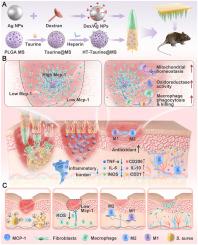细菌微环境反应导弹微针调节免疫并穿透生物膜用于糖尿病伤口治疗
IF 18
1区 医学
Q1 ENGINEERING, BIOMEDICAL
引用次数: 0
摘要
糖尿病伤口影响约25%的糖尿病患者,由于mcp -1介导的免疫失调和细菌生物膜形成驱动的持续炎症,给治疗带来了挑战。我们开发了一种双层微针系统(DAg/HTMS-MNs),将葡聚糖修饰的银纳米粒子与肝素包被的牛磺酸微球结合在一起,用于深层组织抗菌作用。上部微针段通过凝集素靶向和气体推进实现生物膜穿透,而下部微针段实现“全局减压-局部增强”策略:肝素隔离MCP-1以减少炎症细胞募集,持续的牛磺酸释放促进巨噬细胞重编程为M2表型。系统评价表明,同时生物膜根除,炎症消退(2倍增强M2极化),并加速伤口愈合。这种“导弹引导”的方法代表了糖尿病伤口治疗的范式转变,通过空间和时间控制的方式同时解决感染控制、氧化应激和免疫失调。本文章由计算机程序翻译,如有差异,请以英文原文为准。

Bacteria microenvironment-responsive missile microneedles modulate immunity and penetrate biofilm for diabetic wound therapy
Diabetic wounds, affecting ∼25 % of patients with diabetes, present a therapeutic challenge due to persistent inflammation driven by MCP-1-mediated immune dysregulation and bacterial biofilm formation. We developed a bilayer microneedle system (DAg/HTMS-MNs) combining dextran-modified silver nanoparticles for deep-tissue antibacterial action with heparin-coated taurine-loaded microspheres for immunomodulation. The upper microneedle segment enables biofilm penetration through lectin targeting and gas propulsion, while the lower segment implements a “global decompression-local enhancement” strategy: heparin sequesters MCP-1 to reduce inflammatory cell recruitment, and sustained taurine release promotes macrophage reprogramming to M2 phenotypes. Systematic evaluation demonstrated simultaneous biofilm eradication, inflammation resolution (2-fold enhanced M2 polarization), and accelerated wound healing. This “missile-guided” approach represents a paradigm shift in diabetic wound therapy by concurrently addressing infection control, oxidative stress, and immune dysregulation in a spatially and temporally controlled manner.
求助全文
通过发布文献求助,成功后即可免费获取论文全文。
去求助
来源期刊

Bioactive Materials
Biochemistry, Genetics and Molecular Biology-Biotechnology
CiteScore
28.00
自引率
6.30%
发文量
436
审稿时长
20 days
期刊介绍:
Bioactive Materials is a peer-reviewed research publication that focuses on advancements in bioactive materials. The journal accepts research papers, reviews, and rapid communications in the field of next-generation biomaterials that interact with cells, tissues, and organs in various living organisms.
The primary goal of Bioactive Materials is to promote the science and engineering of biomaterials that exhibit adaptiveness to the biological environment. These materials are specifically designed to stimulate or direct appropriate cell and tissue responses or regulate interactions with microorganisms.
The journal covers a wide range of bioactive materials, including those that are engineered or designed in terms of their physical form (e.g. particulate, fiber), topology (e.g. porosity, surface roughness), or dimensions (ranging from macro to nano-scales). Contributions are sought from the following categories of bioactive materials:
Bioactive metals and alloys
Bioactive inorganics: ceramics, glasses, and carbon-based materials
Bioactive polymers and gels
Bioactive materials derived from natural sources
Bioactive composites
These materials find applications in human and veterinary medicine, such as implants, tissue engineering scaffolds, cell/drug/gene carriers, as well as imaging and sensing devices.
 求助内容:
求助内容: 应助结果提醒方式:
应助结果提醒方式:


